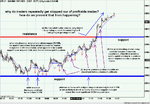Hi, i'm new here, and i'm sure this has been discussed many times on here but i have done a search and can't find any posts (probably because i'm searching on the wrong/inaccurate search terms).
I want to understand the in's and out's of how much "swing" you build in when setting a stop loss. There must be a general formulaic structure to this, and i'm keen to learn about what this might be. I understand the 3:1 risk reward ratio, so how does the stop loss setting swing build this into the equation when determining the point it should be set at.
If anyone could either link me posts that go into detail, or provide a very simple methodology they use, i would really appreciate it.
NB its specifically the amount of swing to build in that i'm curious in i.e. how do you account for particular volatility within whatever you happen to be trading.
Many thanks!
I want to understand the in's and out's of how much "swing" you build in when setting a stop loss. There must be a general formulaic structure to this, and i'm keen to learn about what this might be. I understand the 3:1 risk reward ratio, so how does the stop loss setting swing build this into the equation when determining the point it should be set at.
If anyone could either link me posts that go into detail, or provide a very simple methodology they use, i would really appreciate it.
NB its specifically the amount of swing to build in that i'm curious in i.e. how do you account for particular volatility within whatever you happen to be trading.
Many thanks!

